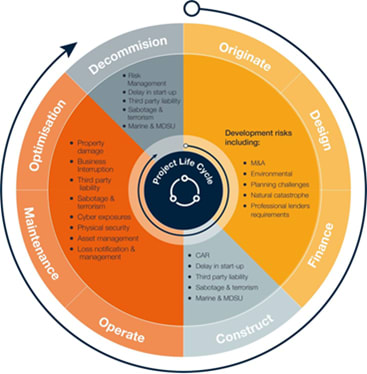Risks are Increasing Throughout the Project Life Cycle
"There is enough finance in the system, but success is linked to a series of challenging interdependencies. SPVs need planning processes to work effectively and the supply chain to be sufficient to meet the demand. You need to also have the labor and the resourcing for these projects to go ahead. So every touchpoint of the industry needs to grow to support the actual ambitions of the sector — at a time when inflationary pressures risk putting the handbrake on progress.”
Guido Benz
CEO Global Renewable Energy, Aon
While the increasing interest of European developers and investors has driven growth in the European wind power industry, the risks associated with the expansion of renewable energy infrastructure are becoming increasingly complex and, as a result, impacting the pace at which ambitions become a reality. As investors enter the market earlier, their exposures to risks are expanding:
- Regulatory hurdles are growing
Price caps implemented by European governments to protect consumers from high energy prices threaten to unnerve investors and stifle energy policy progression. At the same time, protracted planning processes threaten to derail the development of new energy infrastructure, with delayed approval processes creating cost and resource availability risks.
- Supply chain weaknesses are disrupting development
Increasing global demand for the raw materials used in wind technology, such as nickel, steel and, aluminum, is threatening the stability of the supply chain. Since the start of the conflict in Ukraine, imports of finished steel into the EU have dropped by a fifthOpens in a new tab, reflecting Russia and Ukraine’s contribution as major steel producers.
- Tightening economic conditions are increasing costs
As well as inflation pushing up commodity, shipping, labor and transaction costs, a hardening insurance market and increased borrowing costs are making price predictions even more uncertain. After steady decreases in capital expenditure per MW over the last decadeOpens in a new tab, current inflationary pressures will curtail these cost reductions.
- Resource availability threatens to constrain progress
A global shortage of ships used in the transportation and installation of wind turbines is constraining the success of future European wind projects. As competition intensifies and technology evolves, the demand for ships is set to outstrip supply by 2024 — a pressure that is only set to increase as the next generation of turbines will require larger vessels. If any combination of planning, funding or supply chain challenges hold up construction, SPV projects risk significant and costly delays as a result of industry bottlenecks.
- New technology and cyber threats present new challenges
Rapidly evolving technology is transforming the sector but also exposes developers and investors to new risks when scaling up relies on new technology with limited testing. Likewise, as countries rely more on offshore wind for their power needs, the risks of cyber attacks are also likely to increase. From ransomware attacks on the software used to manage, monitor, and control wind power systems to the theft of intellectual property, unprotected vulnerabilities threaten the resilience of SPVs.
- Increasing exposure to severe convective storms
Climate change and more extreme weather events are intensifying risks for the sector — particularly as offshore wind moves from near-shore shallow waters to far-shore deep waters. As a result, securing affordable insurance capacity has become more challenging as insurers and reinsurers try to control risk accumulation. With demand outstripping the supply of resources, developers must also consider the potential business interruption risks as projects attempt to get back up and running.
Today, project risk advisory must be much broader and deeper — from pre-construction through to decommissioning. In the current climate, it’s more important that both investors and developers understand, manage, and mitigate their exposures as early as possible.
Insurance has an expanding role to play within project budgets, and, as current headwinds create new risks for business, those protections must be evaluated — especially by those developers whose budgets have already been set.
Transferring Risk to Accelerate Growth
Comprehensive credit solutions help clients secure receivables, unlock capital and grow trade. These linked credit and insurance tools play an essential role at every stage of a wind project life cycle, helping to reduce credit exposure throughout the lifetime of a transaction.
With regulatory changes and macroeconomics impacting working capital facilities and liquidity, surety bonds are an innovative tool to mobilize capital for the sector. Their deployment is helping wind energy stakeholders to mitigate risk and protect their interests by increasing development capacity and minimizing financial exposure for investors.











































































































































































































































































































































































